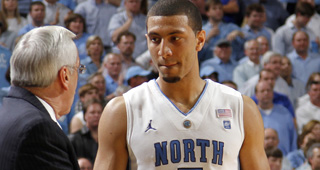Before the NCAA Tournament began, I thought two teams -- Kentucky and UNC -- had separated themselves from the rest of the field. Now, after a wild opening weekend where two No. 1 seeds (UNC and Syracuse) suffered devastating personnel losses, two No. 2 seeds (Duke and Missouri) were knocked out in the first round and two No. 3 seeds (Florida State and Georgetown) lost in the second, the field is as wide open as ever.
While there is more talent in college basketball than in the past few years, the majority of it is in the South Region, which featured two underachieving teams -- UConn and Baylor -- which should have had the talent to keep pace with Kentucky all season. The defending national champion Huskies were undone by a perfect storm of NCAA suspensions, chemistry problems and Jim Calhoun’s medical absence, while Scott Drew’s improperly balanced offense and preposterous 1-3-1 gimmick defense have kept the Bears playing below their talent level most of the season.
Baylor certainly can’t overlook Xavier, a complete team that features a versatile frontcourt and experienced play on the perimeter. Indiana, meanwhile, is one of the few teams in the country with the talent to match up with Kentucky, as they have a 6’10+ center (Cody Zeller) who can muscle Anthony Davis in the paint and get him into foul trouble like he did in the Hoosiers dramatic 73-72 victory over the Wildcats earlier in the season.
And with Kendall Marshall likely out for the Tournament with a wrist injury, there are no other giants looming in the other three regionals. UNC has now lost three scholarship perimeter players to injury this year, with little-used freshmen Stillman White the only scholarship PG still on the roster. Their more realistic option is sliding the 6’5 PJ Hairston into the starting line-up and attempting to swarm teams defensively with their length and athleticism; either way, it’s never good when a team has to dramatically change their identity in the middle of the Tournament.
Neither of the other two No. 1 seeds, Syracuse and Michigan State, have the overwhelming talent advantage that would make them a clear favorite to reach the Final Four. Without Fab Melo, the interior of Jim Boeheim’s 2-3 zone is far less threatening, while their best shot-creator, Dion Waiters, is still coming off the bench. Tom Izzo might be the best coach in college basketball when it comes to tactical adjustments, but Draymond Green is the Spartans’ only reliable shot-creator.
With the exception of Ohio, this year’s Cinderella, none of the other eight teams in the Midwest, East and West Regionals would be overmatched in a match-up with their respective No. 1 seeds. As a result, prognosticating the Sweet 16 is almost hopeless. Even if you look past No. 2 seeds Kansas and Ohio State and No. 3 seed Marquette, all of whom survived tough second round challenges, you can come up with legitimate cases for teams up and down the seed line to eventually advance to New Orleans.
Could Wisconsin’s methodical half-court offense and excellent perimeter shooting slow the tempo down enough to neutralize Syracuse’s defense? Could Cincinnati turn their next two games into the type of ugly Royal Rumble-esque brawl that was their victory over Florida State?
Could Lorenzo Brown and CJ Leslie, two legitimate future first-round picks, outplay their more heralded counterparts in the Midwest Regional? Could Florida, one of the most talented teams in the country, have finally put it together at the right time?
At least 12 teams can make a legitimate case for why they will be headed to Atlanta by the end of the weekend. Even Kentucky, despite their overwhelming dominance all season, can’t rest on their laurels. In a one-game scenario, any team with a very thin bench is one or two close whistles from finding themselves in a dire situation.
The first weekend of the NCAA Tournament was one of the most unpredictable in recent memory. Now, with the second weekend set to tip-off, the Madness may have only just begun.



